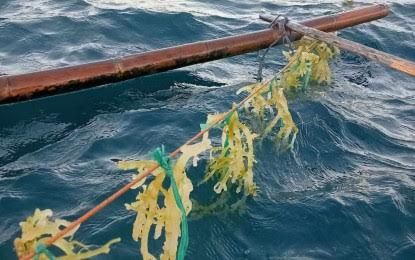Ice-ice strikes due to heat.
At the same time that the Southern Province of Leyte is battling crown of thorns (COT) infestation, Northern Samar's seaweed farms are also plagued.
Due to the extreme heat and the rise of seawater temperature, farmers detected the presence of ice-ice disease (IID) in their seaweed farms. Seaweed farming is a sustainable type of aquaculture that has been their main source of income.
These factors led to temporarily stop of harvesting seaweeds.
Heat and Seaweeds
"The heat index consistently exceeded 40°C, reaching up to 49.3°C. This extreme heat made seaweed production unfeasible as it adversely impacted both shallow and deeper water areas," provincial agriculture officer Jose Luis Acompañado said.
IID is commonly characterized by the whitening and hardening of the seaweed tissues due to the bacteria in the water.
Acompañado said, the phenomenon had already affected farms in the municipalities of Biri, Lavezares, San Antonio, and Capul.
Helpless, local farmers in the area are forced to adjust their cropping season to cooler months to avoid drastic changes in temperature to affect their livelihood.
As water temperatures are beyond man’s control, educating local government units (LGU) and farmers for more alternative ways to protect their crops.
Planting Method
According to a research proposed by Darwin C. Biag from Camarines Norte State College-Institute of Fisheries and Marine Sciences, a planting method can stop early signs of IID from spreading.
“Based on the results and findings, the early onset of ice-ice diseases and epiphyte infestations is attributed to the unsuitable floatation employed by seaweed farmers.
"Newly transplanted seaweeds are vulnerable to ice-ice and epiphyte infestation due to stress accumulated during transplanting and weight loss, which leads to extended exposure to the surface.”
“Therefore, the integration of spacers in existing floats to maintain the desired depth and avoid surface exposure of newly planted seaweed is recommended.”
Avoiding overcrowding the lines and the use of seaweed species resistant to IID are also available and could help the locals have a more resistant harvest.
Climate Change
At this point, due to climate change, the local authorities and concerned government agencies should start looking for more than one way to help the locals who solely rely on the seaweed industry.
Old solutions should be modified if not abandoned and turn to more recent researches and studies that could make the industry more resilient despite the natural challenges that are now recurring.
#WeTakeAStand #OpinYon #OpinYonNews #OpinYonStories
